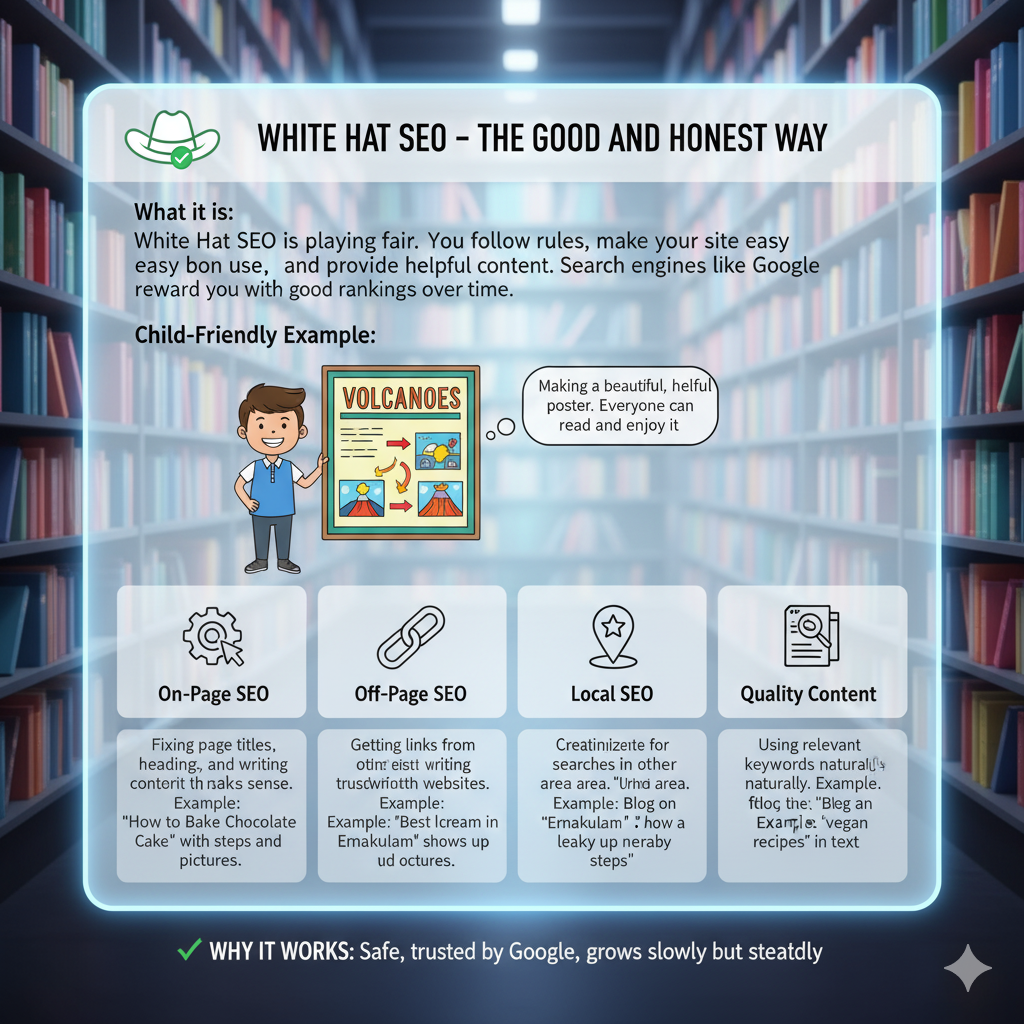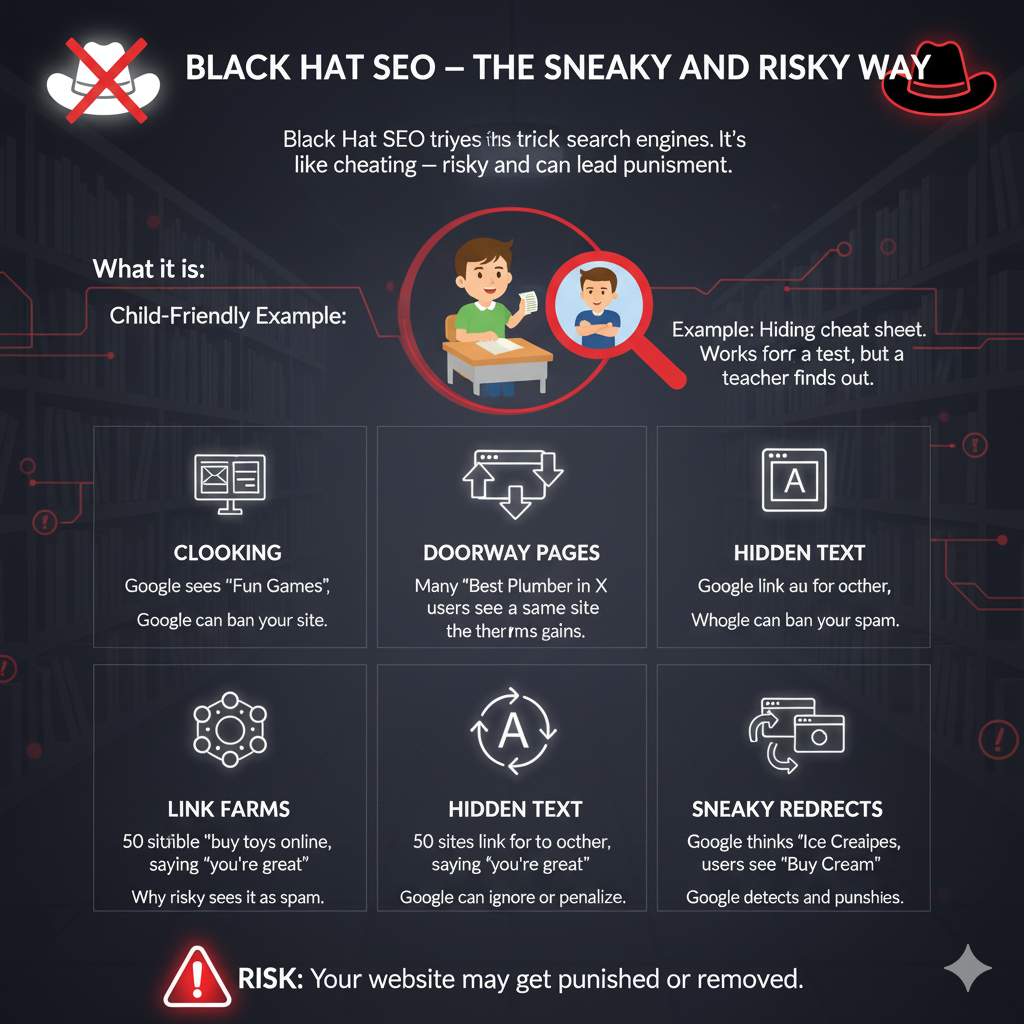Introduction

Imagine the internet as a giant library. Every website is like a book on a shelf, and SEO (Search Engine Optimization) is how you make sure your book is easy to find and read.
Some people follow the rules (good), some cheat (bad), and some try clever shortcuts (risky). This guide explains White Hat, Black Hat, and Grey Hat SEO, with simple examples for each.
White Hat SEO – The Good and Honest Way

What it is:
White Hat SEO is playing fair. You follow the rules, make your site easy to use, and provide helpful content. Search engines like Google reward you with good rankings over time.
Child-Friendly Example:
Think of a student making a beautiful poster for a school project. They use colorful drawings, neat writing, and everything is accurate. Everyone can read and enjoy it — that’s White Hat SEO.
Main Tactics Explained Simply:
- On-Page SEO:
- Fixing page titles, headings, and writing content that makes sense.
- Example: Writing “How to Bake Chocolate Cake” and breaking it into steps with pictures.
- Fixing page titles, headings, and writing content that makes sense.
- Off-Page SEO:
- Getting links from other trustworthy websites.
- Example: Your friend tells their friends to read your poster because it’s helpful.
- Getting links from other trustworthy websites.
- Local SEO:
- Optimizing your website for searches in your area.
- Example: “Best Ice Cream in Ernakulam” shows up when someone nearby searches.
- Optimizing your website for searches in your area.
- Quality Content – Creating useful, informative, and engaging content that helps users find what they need.
Example: A blog explaining how to fix a leaky faucet with step-by-step instructions. - Keyword Research – Using relevant keywords naturally in your content so people can find your page when searching.
Example: If your page is about “vegan recipes,” you use that phrase naturally in titles, headings, and text.
Why it works: Safe, trusted by Google, grows slowly but steadily.
Black Hat SEO – The Sneaky and Risky Way

What it is:
Black Hat SEO tries to trick search engines to rank faster. It’s like cheating — it can work for a while, but if caught, your website may get punished or removed.
Child-Friendly Example:
Imagine a student hiding a small cheat sheet under their desk to get good marks. It might work for one test, but eventually, the teacher finds out — that’s like Black Hat SEO.
Common Tactics Explained Simply:
- Cloaking (or Clocking):
- Showing one page to Google and a different page to users.
- Example: You tell Google your page is about “Fun Games,” but visitors see ads for shoes instead.
- Why risky: Google can detect this and ban your site.
- Showing one page to Google and a different page to users.
- Doorway Pages:
- Doorway pages are special web pages made only to trick search engines. They are designed to rank for specific keywords, but they don’t really give useful information to people. Usually, they just redirect visitors to one main page.
- Example: “Best Plumber in Kochi,” “Best Plumber in Ernakulam,” all take visitors to the same plumber site.
- Why risky: Google sees it as spammy and may remove all pages.
- Doorway pages are special web pages made only to trick search engines. They are designed to rank for specific keywords, but they don’t really give useful information to people. Usually, they just redirect visitors to one main page.
- Hidden Text:
- Hiding keywords that users can’t see (like writing in white on a white page).
- Example: Writing “buy toys online” all over the page but invisible to visitors.
- Why risky: Google considers it cheating.
- Hiding keywords that users can’t see (like writing in white on a white page).
- Link Farms:
- Networks of sites linking to each other just to boost rankings.
- Example: 50 websites telling each other “you’re great” even if they don’t really know each other.
- Why risky: Google can ignore or penalize the links.
- Networks of sites linking to each other just to boost rankings.
- Sneaky Redirects:
- Sending users to a different page than Google expects.
- Example: Google thinks your page is “Ice Cream Recipes” but users see “Buy Ice Cream Online.”
- Sending users to a different page than Google expects.
Keyword stuffing
Keyword stuffing is a Black Hat SEO tactic where a page is loaded with a target keyword (or keyword variations) unnaturally and excessively to try to manipulate search engine rankings. The goal is quantity over quality — force the page to “look” highly relevant to a search engine rather than actually help users.
What it looks like
Bad — keyword stuffing (spammy):
- Page text: “Best shoes, best shoes, best shoes. If you want best shoes buy best shoes from our best shoes store. Best shoes are cheap best shoes best shoes.”
- HTML title: <title>best shoes best shoes best shoes</title>
- Hidden text: <span style=”display:none”>best shoes best shoes</span>
- Meta description: “best shoes, best shoes, best shoes — buy best shoes now!”
3. Grey Hat SEO – The Tricky Middle

What it is:
Grey Hat SEO is in-between. Sometimes it’s clever, sometimes risky. It may boost rankings faster than White Hat, but it can get you in trouble if Google notices.
Child-Friendly Example:
Imagine a student using a “shortcut” to decorate a poster — they borrow some ideas but add their own touch. It looks good, but if the teacher finds out they copied, they may lose marks.
Common Grey Hat Tactics Explained Simply:
- Negative SEO:
- Trying to hurt a competitor’s website.
- Example: Sending spammy links to your friend’s website so Google thinks it’s bad.
- Risk: Can get you banned too; it’s mean and unfair.
- Trying to hurt a competitor’s website.
- SEO Squatting (Domain Squatting):
- Buying a domain similar to a popular brand to get accidental visitors.
- Example: Your friend’s lemonade site is “SunnyLemon.com” and you buy “SunnyLemons.com” to get their visitors.
- Risk: Seen as dishonest and can cause legal problems.
- Buying a domain similar to a popular brand to get accidental visitors.
- Spun Content:
- Rewriting content slightly to make it look new.
- Example: Copying your friend’s drawing but changing colors and shapes a little.
- Risk: Google can detect it and users won’t find it useful.
- Rewriting content slightly to make it look new.
- Paid Links:
- Paying other websites to link to you artificially.
- Example: Giving classmates money to say your poster is the best.
- Risk: Google may ignore the links or penalize your site.
- Paying other websites to link to you artificially.
- Domain Grabbing (Buying Expired Domains):
- Domain grabbing is when someone buys a website domain that someone else owned before but is no longer active. People do this because the old domain might already have:
- Example: Taking over a toy blog that stopped updating to get old visitors.
- Risk: Old domain might have spammy history; risky strategy.
- Domain grabbing is when someone buys a website domain that someone else owned before but is no longer active. People do this because the old domain might already have:
Comparison Table – Easy to Remember
| Type | What it Means | Example | Risk Level |
| White Hat | Honest, safe SEO | Writing helpful guides | Low (Safe) |
| Black Hat | Sneaky tricks | Hidden text, doorway pages | High (Punishable) |
| Grey Hat | Mix of safe and risky | Paid links, spun content | Medium-High (Risky) |
Conclusion
SEO is like a big game or a school project. Playing fair (White Hat SEO) is like doing your homework carefully, using your own ideas, and making it helpful for everyone. It may take time, but the results are long-lasting. Your website will grow steadily, and people will trust it.
Cheating (Black Hat SEO) is like sneaking answers, copying other students’ work, or hiding notes under your desk. It might help you win quickly, but if the teacher (Google) finds out, you could fail the test or get punished. In the world of websites, Black Hat tricks like keyword stuffing, cloaking, doorway pages, and hidden text can lead to your site being removed from search results — which is like being kicked out of the library completely.
Grey Hat SEO is like taking shortcuts that are not clearly right or wrong. Sometimes it works, and sometimes it backfires. You might buy old domains, pay for links, or spin content to get fast attention. But this is risky, and Google might notice later, causing penalties or even long-term damage to your website’s reputation.
The best strategy is to focus on creating helpful, original, and creative content that real users enjoy. Think about what your visitors want to read, watch, or learn — and give them value. Add clear headings, pictures, and make your site easy to navigate. Be patient — good work grows over time.
Remember, SEO is not just about tricking the system. It’s about making the internet a better place where people can find useful and trustworthy information. If you focus on helping others, search engines will notice, your site will gain authority, and your hard work will pay off — safely and steadily. visit our site to learn more samecart